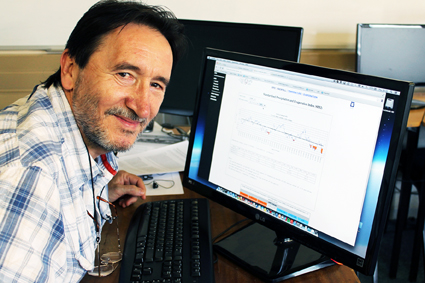Latest information technology employed to make learning in Disaster Management easy

Prof Dusan Sakulski
Photo: Leonie Bolleurs |
Live, colourful, interactive, real-time-calculated. This is how Prof Dusan Sakulski, researcher and lecturer from the UFS’s Disaster Management Training and Education Centre for Africa (DiMTEC), describes his
e-learning platform implemented in this department.
Rather than producing research that gathers dust somewhere in a cabinet, Prof Sakulski believes that research should be used to make life easier, not only for society, but also for his students.
This educational civil engineer, who is responsible for information technology implementation in disaster risk management, developed through his research several programs to optimise the three contact sessions DiMTEC students have to attend each year.
One of the initiatives implemented by Prof Sakulski and his daughter Teodora, was the recording, editing and compiling of theoretical lessons and making it available to students online. “Students then don’t have the excuse of missing a class. Furthermore, it allows them to rather focus on group work during contact sessions and to discuss problems they encountered with the work,” he says.
Students also have access to an early-warning
system portal for the prediction of hazards, including droughts, floods, rain and temperature. In the disaster-risk environment, this program is very useful, not only for students, but also for practitioners working with this kind of data on a daily basis. The operational and educational application works in real time – with the click of a mouse students and practitioners have access to information on current weather conditions. Indicators for possible natural disasters are also built into this program. Truly a useful application when you are working in the field of disaster risk management.
Difficult and technical data are presented live, with information that is colourful, interactive, real-time-calculated and audible, thanks to embedded mathematical language. In this way, students can learn, memorise and understand their work better.